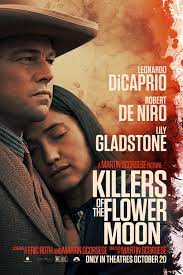Killers of the Flower Moon (2023)


Content by Tony Macklin. Originally published on October 23, 2023 @ tonymacklin.net.
Killers of the Flower Moon can't be a Marty Scorsese film, can it?
It's bloated and lackluster.
It's reminiscent of Michael Cimino's Heaven's Gate (1981). And we know what the reception of Heaven's Gate was. What in Heaven's name is Scorsese doing?
Killers of the Flower Moon is a ponderous tale of exploitation and murder, trust and deception. Based on actual events, captured in a non-fiction book by David Grann, the film tells a story about the Osage tribe in Oklahoma in the 1920s who discovered oil on their arid lands, and became greatly wealthy.
White men moved into the territory and married Osage women. The women were murdered and the men took over control of the oil and the money. The Osage nation was being bilked and their control stolen. Eventually federal agents came to Oklahoma to investigate the sinister events.
The film focuses on a young veteran of WW1 Ernest Burkhart (Leonardo DiCaprio) and his uncle William K. Hale (Robert De Niro) a rich rancher who heads the conspiracy to get the money by nefarious means. He wants Ernest to marry Mollie (Lily Gladstone), an Osage woman. Ernest falls in love with her, but also participates in the corrupt conspiracy.
In early pre-production, Scorsese decided to change the original point of view of the book and his film. He keeps the actual people, but changes the focus. DiCaprio was to portray the federal agent Tom White. But Scorsese changes the emphasis to the Osages, especially Mollie. DiCaprio now plays her husband. Jesse Plemons plays Tom White, but his part is diminished.
Veteran screenwriter Eric Roth (Oscar winner for the adaptation of Forrest Gump, 1994) and Scorsese had to rethink the emphasis and clarity.
It's ironic that Scorsese's emphasis on the Osage makes them often seem like props in the film, rather than effective actors.
Most of the performances are adequate, but only De Niro is at all memorable as Michael Hale, who beneath the philanthropic geniality is sinister. It's his tenth collaboration with Scorsese.
In his sixth collaboration with Scorsese, Leonardo DiCaprio is solid but nothing special. Also adequate is Lily Gladstone as Mollie. But in the latter part of the film she's bedridden and sickly, stricken by poison. She has little to add to her character's status. Sickly is not award winning.
Jesse Plemons is convincing playing Tom White. But he mostly just stands around.
Both veterans Brendan Fraser and John Lithgow yell a lot as attorneys. Where's Pesci?
Of course, Killers of the Flower Moon has creative cinematography by Scorsese veteran Rodrigo Prieto. It is their 4th feature collaboration. The camera is a character in Scorsese's films, so the film is a visual achievement.
The essence of Scorsese's films is energy - both physical and psychological energy. Killers of the Flower Moon lacks that crucial quality. There are moments of volatility - a Scorsese staple - but they don't have the usual Scorsese potency.
The tone may be "mournful," but it's scattered over 3 hours and 26 minutes. That's napful.
A long time ago, I interviewed Marty in his apartment in the hills above La Cienega Boulevard in Los Angeles. I was impressed with how many books he had in his apartment. Teems of them. Like John Huston and Clint Eastwood, Scorsese seems to prefer adapting books into movies.
Scorsese had made four feature films. We talked about Alice Doesn't Live Here Anymore (1974).
"Alice was not fun to me," he said. "It was a draining process because of the personal involvement in it....It's my own relationships with my friends. Harvey (Keitel) - what he represents of me in that film."
And we talked about Mean Streets (1973) - a film I like a lot, more than he did.
"I think Charlie at the end of Mean Streets learns. Sitting there with his shot in the hand, stigmata," he said. "More than ninety-five percent of Mean Streets actually happened."
"I'm not pleased with a lot of things I do," he said. "Especially in Mean Streets, the way I shot a lot of scenes."
It was obvious Marty was committed to technique and style. Scorsese has a reputation for not being able to end his films."Notice the whole sequence (at the end of Alice Doesn't Live Here Anymore) was the only sequence shot with long lenses." He chose to include a talk between the two main characters. People disagreed.
"It's a very personal thing for me. I don't care if the audience doesn't get it," he said.
He talked about how film had changed. "Well, do you think John Ford or Howard Hawks was being interviewed after his fourth film? No way! But the thing that is so earth shaking is you've got to stay personal."
Then he said something that is relevant today. "The old day is dying out, and there is a new Hollywood - definitely is."
Does The Killers of the Flower Moon fit into the new Hollywood in 2023?
Perhaps when we find out Scorsese's values, it won't seem so random.
At the end of Mean Streets, Scorsese appeared as an important character.
50 years later, Scorsese appears at the end of Killers of the Flower Moon as an announcer for a crime drama on the radio. Is Scorsese making a personal statement at the end?
Times change. Attitudes change.
Is film changing for better or worse?






